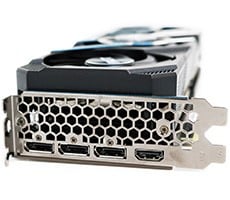GF GTX 680/670 Round Up: EVGA, Zotac, MSI, GB, Asus
Before bringing this article to a close, we'd like to cover a few final data points--namely power consumption, temperatures and noise. Throughout all of our benchmarking and testing, we monitored acoustics and tracked how much power our test system was consuming using a power meter. Our goal was to give you an idea as to how much power each configuration used while idling and also while under a heavy workload. Please keep in mind that we were testing total system power consumption at the outlet here, not just the power being drawn by the graphics cards alone.
|
|
|

Despite the wildly different designs of the cards featured in this round-up, power consumption tracked exactly with GPU / memory frequencies. The highest clocked cards were also the ones that consumed the most power, although the deltas were relatively small. For example, the highest clocked card—the Asus GeForce GTX 680 DirectCU II TOP—consumed only 32 more watts than a reference GeForce GTX 680 card under load. Idle consumption was similar among all of the cards, with only 8 watts separating the highest and lowest values.

In terms of their operating temperatures, the results are almost as varied as the coolers themselves. The coolest running card by a couple of degrees was the Gigabyte GeForce GTX 680 OC with WindForce cooler, followed my MSI, Asus, ZOTAC, and then MSI. Looking at the results, it’s clear the custom coolers are more effective than the reference design (which is used on the EVGA card), but we did experience one anomaly. You’ll notice the ZOTAC GeForce GTX 670 AMP! had higher clocks that it’s GTX 680-based counterpart, even though the latter has higher frequencies and is more powerful. We found that the ZOTAC GeForce GTX 670 AMP!’s cooler wasn’t seated optimally, which was resulting in higher temps. We never experienced any instability or heat-related issues, but re-seating the cooler, applying fresh thermal paste and making sure things were tightly secured brought temps down considerably. We’re reporting the temps as the cards came from the factory though.
In terms of noise output, all of the cards were quiet at idle and inaudible over our PSU fan and CPU cooler. Under load, the fans on each card do spin up considerably, but we would not consider any of the cards loud by any means. The Gigabyte card was most audible, followed by the EVGA card. The differences between the others was negligible.







